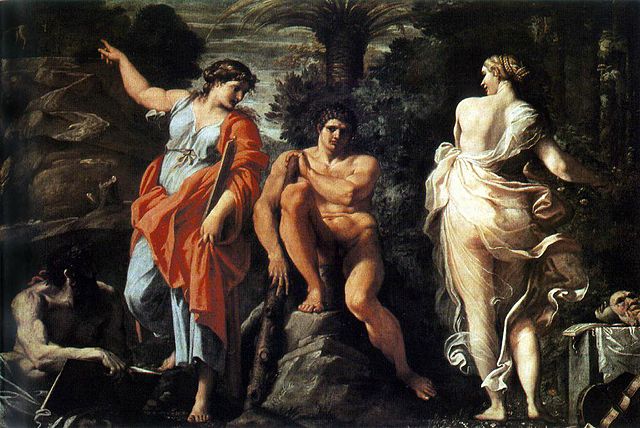
Title: The Choice of Hercules
Artist: Annibale Carracci
Date Painted: c. 1596
Medium: Oil on Canvas
Dimensions: 166cm x 237cm
Period: Baroque
Location: Capodimonte Gallery, Naples
Summary of The Choice of Hercules
Annibale Carracci‘s The Choice of Hercules, also known as “Hercules at the Crossroads,” is a significant painting that epitomizes the Italian Baroque period’s focus on dramatic themes, complex emotions, and moral narratives. Painted in the late 16th century (circa 1596), this work is housed in the Capodimonte Museum in Naples, Italy. The painting illustrates a moment from the life of Hercules, a hero from Greek mythology, who is faced with a choice between two paths in life: one of virtue and the other of vice.
The narrative is derived from a story attributed to the ancient Greek sophist Prodicus, which became a popular theme for artists during the Renaissance and Baroque periods. In Carracci’s interpretation, Hercules is depicted as a young man at a crossroads, physically and metaphorically. He is approached by two female figures, each embodying the contrasting paths his life could take. On one side, Virtue is represented as a noble woman, modestly dressed, gesturing towards a steep and rocky path that leads upwards towards the heavens, symbolizing a life of hard work, integrity, and eventual spiritual reward. On the other side, Vice is depicted as an alluring woman, richly attired and adorned, inviting Hercules to follow a smooth and pleasant path that represents a life of ease, pleasure, and self-indulgence.
Carracci’s composition masterfully contrasts the figures of Virtue and Vice, not only in their attire and posture but also in the symbolic landscapes that lie behind them. The painting is celebrated for its dynamic composition, the emotional complexity of Hercules as he contemplates his choice, and the detailed depiction of the figures and the landscape. Carracci’s use of color, light, and shadow enhances the drama and depth of the scene, drawing viewers into the moral quandary faced by Hercules.
The Choice of Hercules reflects the Baroque era’s interest in depicting psychological depth and moral dilemmas, offering viewers not just a visual spectacle but also a contemplative experience. Through this painting, Carracci explores themes of morality, temptation, and the human condition, encouraging viewers to reflect on the choices they face in their own lives. The work is a testament to Carracci’s skill as a painter and his ability to convey complex narratives and emotional states through his art.